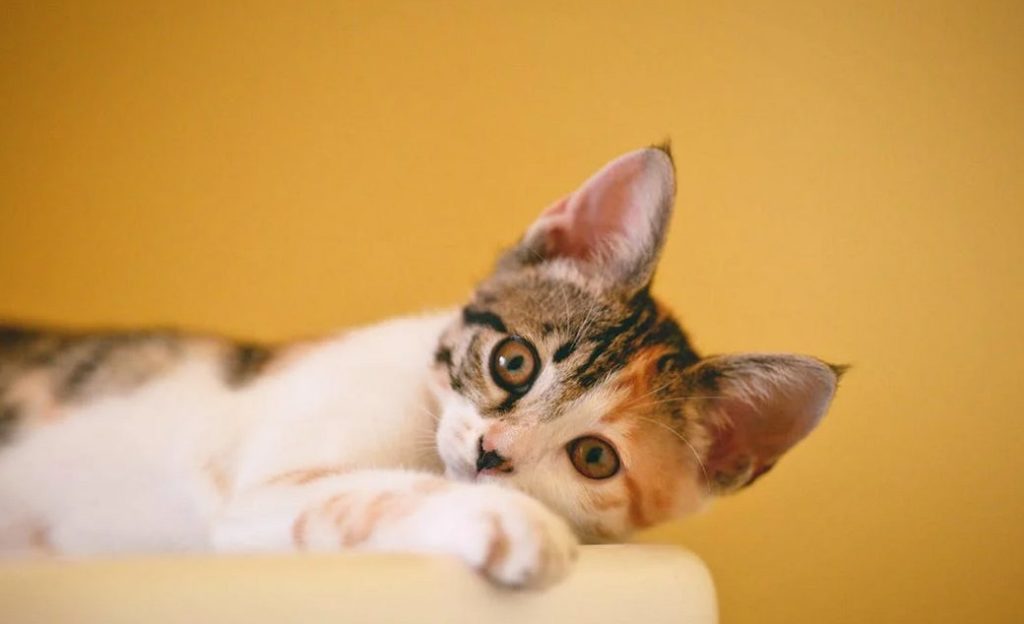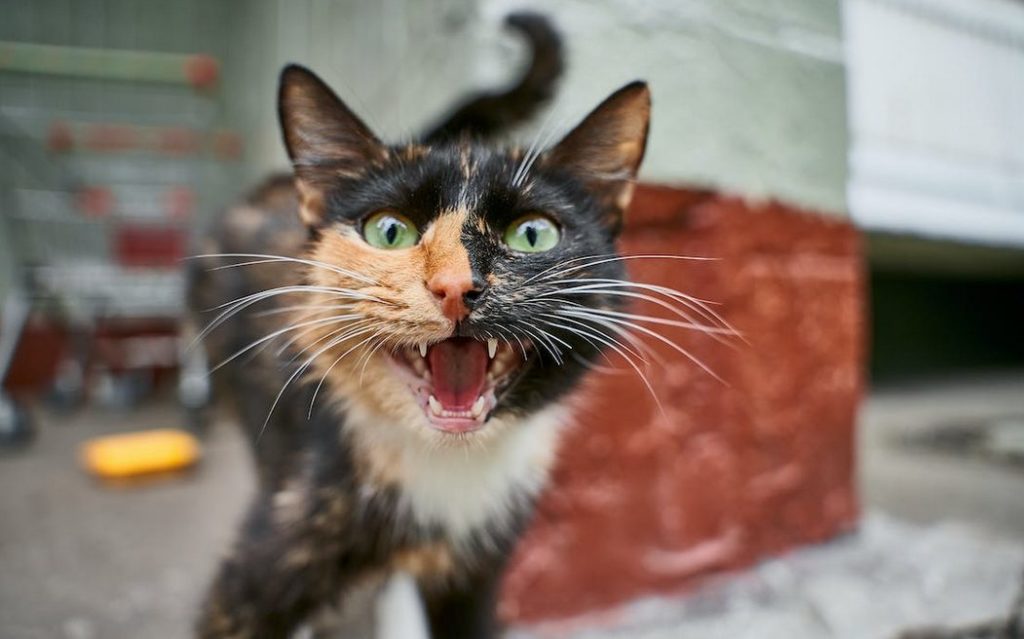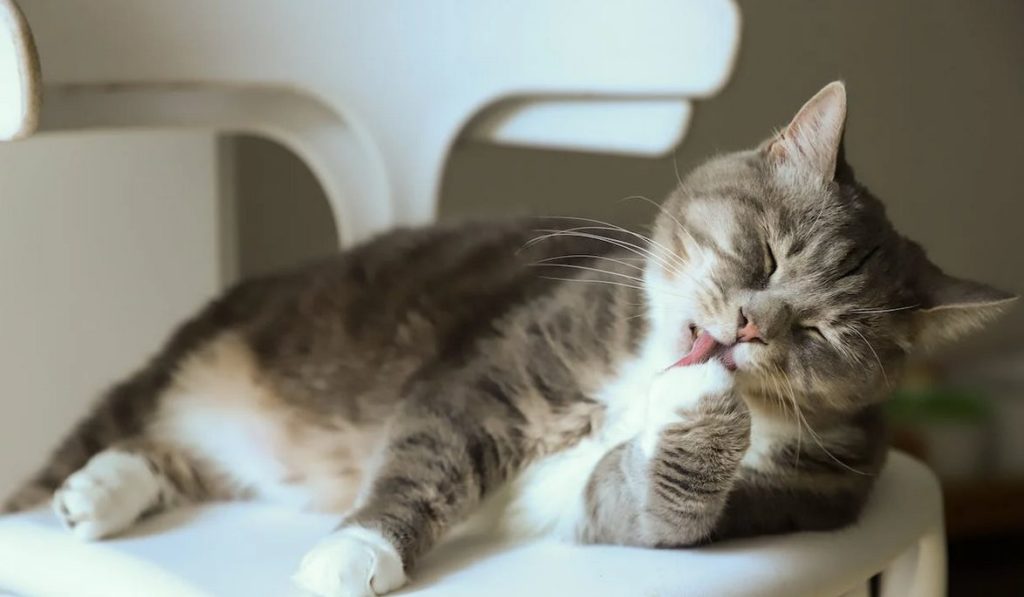Cat Overgrooming is a common behavioral issue that affects many feline owners. It occurs when a cat licks, bites, or chews its fur excessively, resulting in hair loss, skin irritation, or even wounds.
Cat overgrooming can have negative effects on their health and well-being. We’ll explore the causes, links to anxiety, and prevention strategies. We’ll also cover treatment costs and the potential benefits of calming treats.
Why Is My Cat Overgrooming?
Cats are natural groomers, spending up to 50% of their waking hours cleaning themselves. Grooming helps them maintain hygiene, regulate body temperature, and express emotions.
However, when grooming becomes excessive or compulsive, it can indicate a deeper issue. Some of the common causes of cat overgrooming are:
Stress, anxiety, and boredom:

Cats are sensitive creatures that can experience stress and anxiety due to various factors, such as changes in their environment, routine, or social dynamics, lack of stimulation or enrichment, separation from their owners, or exposure to loud noises or unfamiliar stimuli.
Stress and anxiety can trigger overgrooming as a coping mechanism or a self-soothing behavior. Boredom can also lead to overgrooming, as cats may lick themselves to relieve frustration or boredom.
Medical conditions:
Overgrooming can also indicate an underlying medical condition that causes discomfort, pain, or itching in your cat.
Some possible medical conditions that can trigger overgrooming are allergies, parasites, infections, hormonal imbalances, arthritis, dental problems, or neurological disorders.
If your cat is overgrooming, it is important to consult a veterinarian to rule out any medical causes.
Is It Anxiety When a Cat Overgrooms?

Anxiety is one of the most common psychological causes of cat overgrooming. Anxiety can be defined as a state of fear, nervousness, or apprehension that is disproportionate to the actual threat or situation.
Anxiety can affect cats of any age, breed, or personality and can be triggered by various factors, such as trauma, abuse, neglect, abandonment, or loss of a companion.
Anxiety can also be caused by environmental stressors, such as moving to a new home, introducing a new pet or family member, or having guests or strangers in the house.
Anxiety can manifest itself in different ways in cats, such as hiding, aggression, vocalization, elimination problems, or overgrooming.
Overgrooming is a common way for anxious cats to cope with their negative emotions, as licking releases endorphins, which are natural chemicals that induce a sense of calm and pleasure.
However, overgrooming can also worsen anxiety, as it can create a vicious cycle of stress and discomfort. Overgrooming can damage the skin and fur, leading to inflammation, infection, or pain, further increasing anxiety and overgrooming.
To determine if your cat is overgrooming due to anxiety, you need to observe its behavior and look for other signs of anxiety, such as:
- Dilated pupils
- Ears flattened or rotated backward.
- Tail tucked under the body or flicking rapidly.
- Body posture low or crouched
- Excessive vocalization or silence
- Hiding or avoiding contact
- Aggression or defensiveness
- Changes in appetite or litter box habits
- Destructive behavior or scratching
Suppose you suspect that your cat is overgrooming due to anxiety. In that case, you should seek professional help from a veterinarian or an animal behaviorist, who can diagnose the problem and provide appropriate treatment.
How To Stop Cat Overgrooming?
Cat overgrooming can be a challenging problem, as it can have multiple causes and become a deeply ingrained habit. However, there are some effective strategies that you can implement to stop and prevent cat overgrooming, such as:
Providing a stimulating environment to keep your cat engaged:

One of the best ways to reduce overgrooming is to provide your cat with a stimulating and enriching environment that caters to its instincts and needs.
This can include providing your cat with:
- A safe and comfortable space where it can rest, sleep, and hide
- A variety of scratching posts, perches, and cat trees where it can climb, explore, and mark its territory
- A window where it can watch the outside world and enjoy the sunlight
- A water fountain or a bowl of fresh water where it can drink and play
- A litter box that is clean, spacious, and accessible
- A balanced and nutritious diet that meets its dietary requirements and preferences
Introducing interactive toys and activities to distract from overgrooming:
Another way to reduce overgrooming is to provide your cat with interactive toys and activities that distract it from licking itself and keep it mentally and physically stimulated.
This can include providing your cat with:
- A variety of toys that appeal to its senses, such as balls, feathers, mice, or lasers
- A puzzle feeder or a treat dispenser that challenges its intelligence and rewards its efforts
- A catnip toy or a spray that induces a positive and playful mood
- A fishing pole or a wand toy that mimics the movement of prey and encourages its hunting instincts
- A cardboard box or a paper bag that stimulates its curiosity and exploration
It would help if you also spent quality time with your cat daily, playing, cuddling, or grooming it, to strengthen your bond and provide it with social interaction and affection.
Implementing a regular grooming routine to maintain healthy fur and skin:
Another way to reduce overgrooming is to implement a regular grooming routine that helps your cat maintain healthy fur and skin and prevents matting, tangling, or shedding. This can include:
- Brushing your cat’s fur gently and regularly, using a suitable brush or comb that matches its coat type and length
- Trimming your cat’s nails carefully and regularly, using a proper nail clipper or a file that does not hurt or damage its claws
- Cleaning your cat’s ears, eyes, and teeth gently and regularly, using a soft cloth, a cotton ball, or a pet toothbrush and toothpaste that are safe and appropriate for cats
- Bathing your cat occasionally and only when necessary, using a mild shampoo and warm water that is suitable for cats
Grooming your cat can also help you bond with your cat and provide it with positive reinforcement and praise.
How To Break The Cycle Of Cat Overgrooming?
While the strategies mentioned above can help you stop and prevent cat overgrooming, sometimes they may not be enough to break the cycle of this compulsive behavior.
In some cases, cat overgrooming may require professional help from a veterinarian or an animal behaviorist, who can provide more specialized and personalized treatment.
Some of the possible treatments that they can offer are:
Identifying and addressing underlying medical conditions:
If your cat is overgrooming due to a medical condition, such as allergies, parasites, infections, hormonal imbalances, arthritis, dental problems, or neurological disorders, your veterinarian can diagnose the condition and prescribe the appropriate medication, treatment, or surgery to relieve your cat’s symptoms and discomfort.
Your veterinarian can also advise you on how to prevent or manage the condition in the future and how to care for your cat’s fur and skin during and after the treatment.
Implementing behavior modification techniques to break the overgrooming habit:
If your cat is overgrooming due to a psychological cause, such as stress, anxiety, or boredom, your animal behaviorist can help you identify the source of the problem and implement behavior modification techniques to break the overgrooming habit.
Some of the possible techniques are:
Counter conditioning:
This technique involves changing your cat’s negative association with a certain stimulus or situation into a positive one by pairing it with something your cat likes, such as food, toys, or attention.
For example, if your cat overgrooms when it hears a loud noise, you can treat or play with it every time it hears it to make it associate the noise with something pleasant and reduce its anxiety and overgrooming.
Desensitization:
This technique involves gradually exposing your cat to a certain stimulus or situation that causes it stress or anxiety, starting from low intensity and increasing it gradually until your cat becomes accustomed to it and no longer reacts with overgrooming.
For example, suppose your cat overgrooms when it sees a new pet or family member. In that case, you can introduce them slowly and gradually, keeping them at a safe distance and increasing their proximity and interaction until your cat becomes comfortable and relaxed with them and stops overgrooming.
Distraction:
This technique involves diverting your cat’s attention from overgrooming by providing an alternative, more rewarding, satisfying, and satisfying activity.
For example, if your cat overgrooms when bored, you can distract it by providing it with a clicker or a whistle that signals your cat to perform a desired behavior and rewards it with a treat or praise.
Your animal behaviorist can also prescribe anti-anxiety medication or supplements for your cat, if necessary, to help it cope with its stress and anxiety and reduce its overgrooming.
Do Calming Treats Help With Cat Overgrooming?
Calming treats are pet products that claim to help reduce stress and anxiety in cats and dogs. They usually contain natural ingredients, such as chamomile, lavender, valerian, or hemp, that are supposed to have a soothing and relaxing effect on your pet.
Calming treats are available in various forms, such as chews, biscuits, drops, or sprays, and can be given to your cat before or during a stressful situation, such as a vet visit, a car ride, or a thunderstorm.
But do calming treats help with cat overgrooming?
The answer is that it depends. Calming treats may work for some cats but not others, depending on their personality, temperament, and sensitivity. Calming treats may also have different effects on different cats, depending on the dosage, frequency, and duration of use.
Some cats may experience a noticeable improvement in their mood and behavior. While others may show no change or even adverse reactions, such as drowsiness, nausea, or diarrhea.
Therefore, before giving your cat any calming treats. Consult your veterinarian to determine if they are safe and suitable for your cat.
You should also follow the instructions on the label carefully and monitor your cat’s response and tolerance to the treats. It will help if you remember that calming treats are not a cure for cat overgrooming but a temporary and supplementary measure to help your cat cope with stress and anxiety.
Calming treats should not replace proper diagnosis and treatment of the underlying cause of overgrooming, nor should they substitute for environmental and behavioral interventions to help your cat overcome its overgrooming habit.
How Much Will It Cost To Treat Cat Overgrooming?
The expenses of treating a cat suffering from overgrooming can vary depending on several factors. These factors include the availability of the service, whether it is located in a remote or local area, and whether the service is in high demand.
The costs can add up quickly, including veterinary visits, tests, medications, treatments, or surgeries.
Conclusion
Cat overgrooming is a serious and complex problem affecting your cat’s health and happiness. It can have various causes, both psychological and physical, and can require different treatments, depending on the individual case.
Cat overgrooming can also be costly, involving various expenses, such as veterinary visits, tests, medications, treatments, or surgeries. However, cat overgrooming can also be prevented and stopped with the help of some effective strategies, such as providing a stimulating environment, introducing interactive toys and activities, implementing a regular grooming routine, seeking professional help, and using calming treats.
By understanding and addressing your cat’s overgrooming, you can help your cat overcome this problem and enjoy a healthy and happy life. If you find this article helpful and would like to reach out to us, please don’t hesitate to do so.
With a passion for cats and years of experience in cat care and grooming, I have gained valuable insights and expertise that I want to share with other cat lovers. I believe that every cat deserves the best care possible, and through this platform, I aim to empower cat owners like you to provide the utmost love and care for your feline companions.



